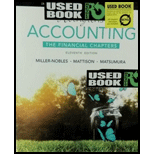
Concept Introduction
Cash Ratio: Cash Ratio is a financial liquidity ratio that measures the ability of an organization to meet its short-term obligations with only cash and cash equivalents. It is measured as a ratio of total cash and cash equivalents to current liabilities.
Acid-Test Ratio: Acid-Test Ratio is a financial liquidity ratio that measures the ability of an organization to meet its short-term obligations with its quick assets. The quick assets usually include cash, marketable securities and accounts receivables. It is measured as a ratio of quick assets to current liabilities.
Debt Ratio: Debt ratio is a financial ratio that shows the percentage of total assets that is financed by the total liabilities of a company.
Debt Equity Ratio: Debt Equity Ratio is a financial leverage ratio that shows what proportion of debt an organization is using to finance its assets relative to shareholder’s equity. It is measured as a ratio of total debt to total
1.
To Compute: The given ratios that are current ratio, cash ratio, acid-test ratio, debt ratio and debt to equity ratio for 2016 and 2015.
2.
To Evaluate: The company’s ability to pay its current liabilities and total liabilities.
Want to see the full answer?
Check out a sample textbook solution
Chapter 17 Solutions
Horngren's Accounting, The Financial Chapters (11th Edition) - Standalone Book
- I need help finding the accurate solution to this general accounting problem with valid methods.arrow_forwardCan you help me solve this general accounting problem with the correct methodology?arrow_forwardKindly help me with this General accounting questions not use chart gpt please fast given solutionarrow_forward
- Please given correct answer for General accounting question I need step by step explanationarrow_forwardCan you solve this general accounting problem with appropriate steps and explanations?arrow_forwardPlease explain the solution to this general accounting problem with accurate explanations.arrow_forward
- Patricia receives $65,000 worth of Nextech, Inc., common stock from her uncle's estate. Early in the year, she receives a $320 cash dividend. Three months later, she received a 3% stock dividend. Near the end of the year, Patricia sells the stock for $68,500. Due to these events only, how much must Patricia include in her gross income for the year?arrow_forwardI am searching for the correct answer to this general accounting problem with proper accounting rules.arrow_forwardGriffin Manufacturing has provided the following data for the month of March. The balance in the Finished Goods inventory account at the beginning of the month was $95,200 and at the end of the month was $89,600. The cost of goods manufactured for the month was $428,300. The actual manufacturing overhead cost incurred was $142,700 and the manufacturing overhead cost applied to jobs was $146,500. The adjusted cost of goods sold that would appear on the income statement for March is __.arrow_forward

 AccountingAccountingISBN:9781337272094Author:WARREN, Carl S., Reeve, James M., Duchac, Jonathan E.Publisher:Cengage Learning,
AccountingAccountingISBN:9781337272094Author:WARREN, Carl S., Reeve, James M., Duchac, Jonathan E.Publisher:Cengage Learning, Accounting Information SystemsAccountingISBN:9781337619202Author:Hall, James A.Publisher:Cengage Learning,
Accounting Information SystemsAccountingISBN:9781337619202Author:Hall, James A.Publisher:Cengage Learning, Horngren's Cost Accounting: A Managerial Emphasis...AccountingISBN:9780134475585Author:Srikant M. Datar, Madhav V. RajanPublisher:PEARSON
Horngren's Cost Accounting: A Managerial Emphasis...AccountingISBN:9780134475585Author:Srikant M. Datar, Madhav V. RajanPublisher:PEARSON Intermediate AccountingAccountingISBN:9781259722660Author:J. David Spiceland, Mark W. Nelson, Wayne M ThomasPublisher:McGraw-Hill Education
Intermediate AccountingAccountingISBN:9781259722660Author:J. David Spiceland, Mark W. Nelson, Wayne M ThomasPublisher:McGraw-Hill Education Financial and Managerial AccountingAccountingISBN:9781259726705Author:John J Wild, Ken W. Shaw, Barbara Chiappetta Fundamental Accounting PrinciplesPublisher:McGraw-Hill Education
Financial and Managerial AccountingAccountingISBN:9781259726705Author:John J Wild, Ken W. Shaw, Barbara Chiappetta Fundamental Accounting PrinciplesPublisher:McGraw-Hill Education





